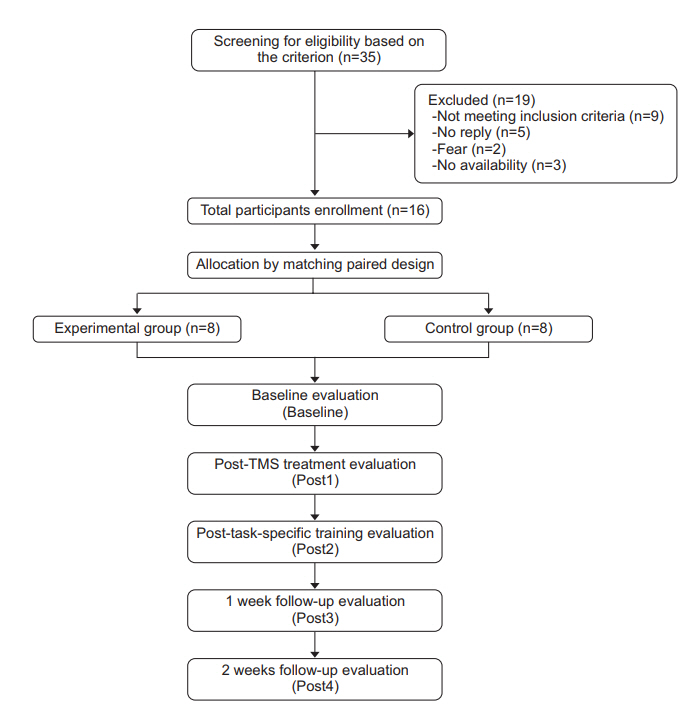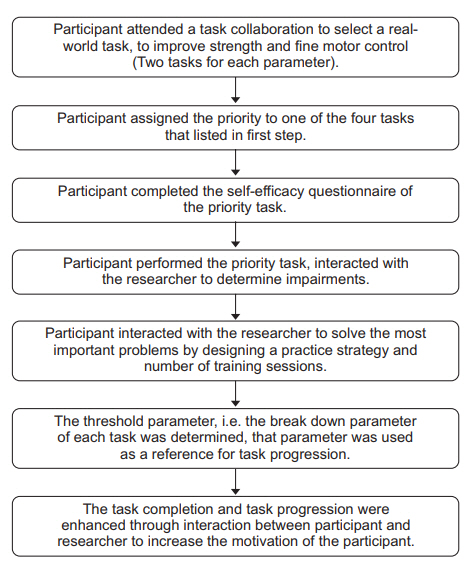Ann Rehabil Med.
2018 Dec;42(6):777-787. 10.5535/arm.2018.42.6.777.
The Persisted Effects of Low-Frequency Repetitive Transcranial Magnetic Stimulation to Augment Task-Specific Induced Hand Recovery Following Subacute Stroke: Extended Study
- Affiliations
-
- 1Motor Control and Neural Plasticity Laboratory, Faculty of Physical Therapy, Mahidol University, Nakhon Pathom, Thailand. jarugool.tre@mahidol.ac.th
- 2Faculty of Physical Therapy, Mahidol University, Nakhon Pathom, Thailand.
- 3Faculty of Medicine Siriraj Hospital, Mahidol University, Bangkok, Thailand.
- 4Faculty of Engineering, King Mongkut's Institute of Technology Ladkrabang, Bangkok, Thailand.
- KMID: 2448898
- DOI: http://doi.org/10.5535/arm.2018.42.6.777
Abstract
OBJECTIVE
To examine the long-term effects of the low-frequency repetitive transcranial magnetic stimulation (LFrTMS) combined with task-specific training on paretic hand function following subacute stroke.
METHODS
Sixteen participants were randomly selected and grouped into two: the experimental group (real LFrTMS) and the control group (sham LF-rTMS). All the 16 participants were then taken through a 1-hour taskspecific training of the paretic hand. The corticospinal excitability (motor evoke potential [MEP] amplitude) of the non-lesioned hemisphere, and the paretic hand performance (Wolf Motor Function Test total movement time [WMFT-TMT]) were evaluated at baseline, after the LF-rTMS, immediately after task-specific training, 1 and 2 weeks after the training.
RESULTS
Groups comparisons showed a significant difference in the MEP after LF-rTMS and after the training. Compared to the baseline, the MEP of the experimental group significantly decreased after LF-rTMS and after the training and that effect was maintained for 2 weeks. Group comparisons showed significant difference in WMFT-TMT after the training. Only in the experimental group, the WMFT-TMT of the can lifting item significantly reduced compared to the baseline and the effect was sustained for 2 weeks.
CONCLUSION
The results of this study established that the improvement in paretic hand after task-specific training was enhanced by LF-rTMS and it persisted for at least 2 weeks.
Figure
Reference
-
1. American Stroke Association. Impact of stroke (stroke statistics) [Internet]. Dallas: American Stroke Association;2016. [cited 2018 Nov 15]. Available from: http://www.strokeassociation.org/STROKEORG/AboutStroke/Impact-of-Stroke-Stroke-statistics_UCM_310728_Article.jsp#.W_dlSOgzaUl.2. Thrasher TA, Zivanovic V, McIlroy W, Popovic MR. Rehabilitation of reaching and grasping function in severe hemiplegic patients using functional electrical stimulation therapy. Neurorehabil Neural Repair. 2008; 22:706–14.
Article3. Harris-Love ML, Cohen LG. Noninvasive cortical stimulation in neurorehabilitation: a review. Arch Phys Med Rehabil. 2006; 87(12 Suppl 2):S84–93.
Article4. Fregni F, Pascual-Leone A. Hand motor recovery after stroke: tuning the orchestra to improve hand motor function. Cogn Behav Neurol. 2006; 19:21–33.
Article5. Shimizu T, Hosaki A, Hino T, Sato M, Komori T, Hirai S, et al. Motor cortical disinhibition in the unaffected hemisphere after unilateral cortical stroke. Brain. 2002; 125(Pt 8):1896–907.
Article6. Park E, Kim YH, Chang WH, Kwon TG, Shin YI. Interhemispheric modulation of dual-mode, noninvasive brain stimulation on motor function. Ann Rehabil Med. 2014; 38:297–303.
Article7. Murase N, Duque J, Mazzocchio R, Cohen LG. Influence of interhemispheric interactions on motor function in chronic stroke. Ann Neurol. 2004; 55:400–9.
Article8. Bütefisch CM, Wessling M, Netz J, Seitz RJ, Homberg V. Relationship between interhemispheric inhibition and motor cortex excitability in subacute stroke patients. Neurorehabil Neural Repair. 2008; 22:4–21.
Article9. Takeuchi N, Chuma T, Matsuo Y, Watanabe I, Ikoma K. Repetitive transcranial magnetic stimulation of contralesional primary motor cortex improves hand function after stroke. Stroke. 2005; 36:2681–6.
Article10. Dafotakis M, Grefkes C, Wang L, Fink GR, Nowak DA. The effects of 1 Hz rTMS over the hand area of M1 on movement kinematics of the ipsilateral hand. J Neural Transm (Vienna). 2008; 115:1269–74.11. Takeuchi N, Tada T, Toshima M, Chuma T, Matsuo Y, Ikoma K. Inhibition of the unaffected motor cortex by 1 Hz repetitive transcranical magnetic stimulation enhances motor performance and training effect of the paretic hand in patients with chronic stroke. J Rehabil Med. 2008; 40:298–303.
Article12. Takeuchi N, Toshima M, Chuma T, Matsuo Y, Ikoma K. Repetitive transcranial magnetic stimulation of the unaffected hemisphere in a patient who was forced to use the affected hand. Am J Phys Med Rehabil. 2008; 87:74–7.
Article13. Vongvaivanichakul P, Tretriluxana J, Bovonsunthonchai S, Pakaprot N, Laksanakorn W. Reach-to-grasp training in individuals with chronic stroke augmented by low-frequency repetitive transcranial magnetic stimulation. J Med Assoc Thai. 2014; 97 Suppl 7:S45–9.14. Thanakamchokchai J, Tretriluxana J, Jalayondeja C, Pakaprot N. Immediate effects of low-frequency repetitive transcranial magnetic stimulation to augment task-specific training in sub-acute stroke. Asia Pac J Sci Technol. 2015; 20:105–19.15. Bolognini N, Pascual-Leone A, Fregni F. Using noninvasive brain stimulation to augment motor traininginduced plasticity. J Neuroeng Rehabil. 2009; 6:8.
Article16. Winstein CJ, Wolf SL. Task-oriented training to promote upper extremity recovery. In : Stein J, Harvey RL, Macko RF, Winstein CJ, Zorowitz RD, editors. Stroke recovery and rehabilitation. New York: Demos Medical Publishing;2009. p. 267–90.17. Dobkin BH. Strategies for stroke rehabilitation. Lancet Neurol. 2004; 3:528–36.
Article18. Liepert J. Motor cortex excitability in stroke before and after constraint-induced movement therapy. Cogn Behav Neurol. 2006; 19:41–7.
Article19. Ertelt D, Small S, Solodkin A, Dettmers C, McNamara A, Binkofski F, et al. Action observation has a positive impact on rehabilitation of motor deficits after stroke. Neuroimage. 2007; 36 Suppl 2:T164–73.
Article20. Hummel FC, Cohen LG. Non-invasive brain stimulation: a new strategy to improve neurorehabilitation after stroke? Lancet Neurol. 2006; 5:708–12.
Article21. Tretriluxana J, Runnarong N, Tretriluxana S, Prayoonwiwat N, Vachalathiti R, Winstein C. Feasibility investigation of the Accelerated Skill Acquisition Program (ASAP): insights into reach-to-grasp coordination of individuals with postacute stroke. Top Stroke Rehabil. 2013; 20:151–60.
Article22. Kleim JA, Jones TA. Principles of experience-dependent neural plasticity: implications for rehabilitation after brain damage. J Speech Lang Hear Res. 2008; 51:S225–39.
Article23. Conforto AB, Cohen LG. Transcranial magnetic stimulation and brain plasticity. In : Hallett M, Chokroverty S, editors. Magnetic stimulation in clinical neurophysiology. 2nd ed. Philadelphia: Elsevier;2005. p. 143–54.24. Wassermann EM. Risk and safety of repetitive transcranial magnetic stimulation: report and suggested guidelines from the International Workshop on the Safety of Repetitive Transcranial Magnetic Stimulation, June 5-7, 1996. Electroencephalogr Clin Neurophysiol. 1998; 108:1–16.
Article25. Maeda F, Pascual-Leone A. Transcranial magnetic stimulation: studying motor neurophysiology of psychiatric disorders. Psychopharmacology (Berl). 2003; 168:359–76.
Article26. Rose DK, Patten C, McGuirk TE, Lu X, Triggs WJ. Does inhibitory repetitive transcranial magnetic stimulation augment functional task practice to improve arm recovery in chronic stroke? Stroke Res Treat. 2014; 2014:305236.
Article27. Kakuda W, Abo M, Shimizu M, Sasanuma J, Okamoto T, Yokoi A, et al. A multi-center study on low-frequency rTMS combined with intensive occupational therapy for upper limb hemiparesis in post-stroke patients. J Neuroeng Rehabil. 2012; 9:4.
Article28. Chen R, Classen J, Gerloff C, Celnik P, Wassermann EM, Hallett M, et al. Depression of motor cortex excitability by low-frequency transcranial magnetic stimulation. Neurology. 1997; 48:1398–403.
Article29. Krakauer JW. Motor learning: its relevance to stroke recovery and neurorehabilitation. Curr Opin Neurol. 2006; 19:84–90.
Article30. Liepert J, Uhde I, Graf S, Leidner O, Weiller C. Motor cortex plasticity during forced-use therapy in stroke patients: a preliminary study. J Neurol. 2001; 248:315–21.
Article31. Liepert J, Bauder H, Wolfgang HR, Miltner WH, Taub E, Weiller C. Treatment-induced cortical reorganization after stroke in humans. Stroke. 2000; 31:1210–6.
Article32. Ziemann U. TMS induced plasticity in human cortex. Rev Neurosci. 2004; 15:253–66.
Article33. Thickbroom GW. Transcranial magnetic stimulation and synaptic plasticity: experimental framework and human models. Exp Brain Res. 2007; 180:583–93.
Article34. Avenanti A, Coccia M, Ladavas E, Provinciali L, Ceravolo MG. Low-frequency rTMS promotes use-dependent motor plasticity in chronic stroke: a randomized trial. Neurology. 2012; 78:256–64.
Article35. Higgins J, Koski L, Xie H. Combining rTMS and taskoriented training in the rehabilitation of the arm after stroke: a pilot randomized controlled trial. Stroke Res Treat. 2013; 2013:539146.
Article
- Full Text Links
- Actions
-
Cited
- CITED
-
- Close
- Share
- Similar articles
-
- Comparison of Effects of Repetitive Transcranial Magnetic Stimulation with High- or Low-frequency on Visuospatial Neglect in Stroke Patients
- Effects of Hand Training During the Aftereffect Period of Low-Frequency rTMS in Subacute Stroke Patients
- Motor Recovery after Seizure Induced by Repetitive Transcranial Magnetic Stimulation
- Comparison of the Effects of 1 Hz and 20 Hz rTMS on Motor Recovery in Subacute Stroke Patients
- Noninvasive brain stimulation: repetitive transcranial magnetic stimulation and transcranial direct current stimulation



